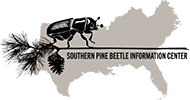Abstract
Conifer bark beetles attack and kill mature spruce and pine trees, especially during hot and dry conditions. These beetles are closely associated with ophiostomatoid fungi of the Ascomycetes, including the genera Ophiostoma, Grosmannia, and Endoconidiophora, which enhance beetle success by improving nutrition and modifying their substrate, but also have negative impacts on beetles by attracting predators and parasites. A survey of the literature and our own data revealed that ophiostomatoid fungi emit a variety of volatile organic compounds under laboratory conditions including fusel alcohols, terpenoids, aromatic compounds, and aliphatic alcohols. Many of these compounds already have been shown to elicit behavioral responses from bark beetles, functioning as attractants or repellents, often as synergists to compounds currently used in bark beetle control. Thus, these compounds could serve as valuable new agents for bark beetle management. However, bark beetle associations with fungi are very complex. Beetle behavior varies with the species of fungus, the stage of the beetle life cycle, the host tree quality, and probably with changes in the emission rate of fungal volatiles. Additional research on bark beetles and their symbiotic associates is necessary before the basic significance of ophiostomatoid fungal volatiles can be understood and their applied potential realized.
Keywords
Symbiosis, Pest management, Fusel alcohol, Aliphatic alcohol, Aromatic compound, Terpenoid, Ophiostoma, Grosmannia, Endoconidiophora, Ips, Dendroctonus
To read the full article please visit the link below:
Kandasamy, Dineshkumar, Jonathan Gershenzon, and Almuth Hammerbacher. 2016. “Volatile Organic Compounds Emitted by Fungal Associates of Conifer Bark Beetles and Their Potential in Bark Beetle Control.” Journal of Chemical Ecology 42 (9): 952–69. https://doi.org/10.1007/s10886-016-0768-x.
